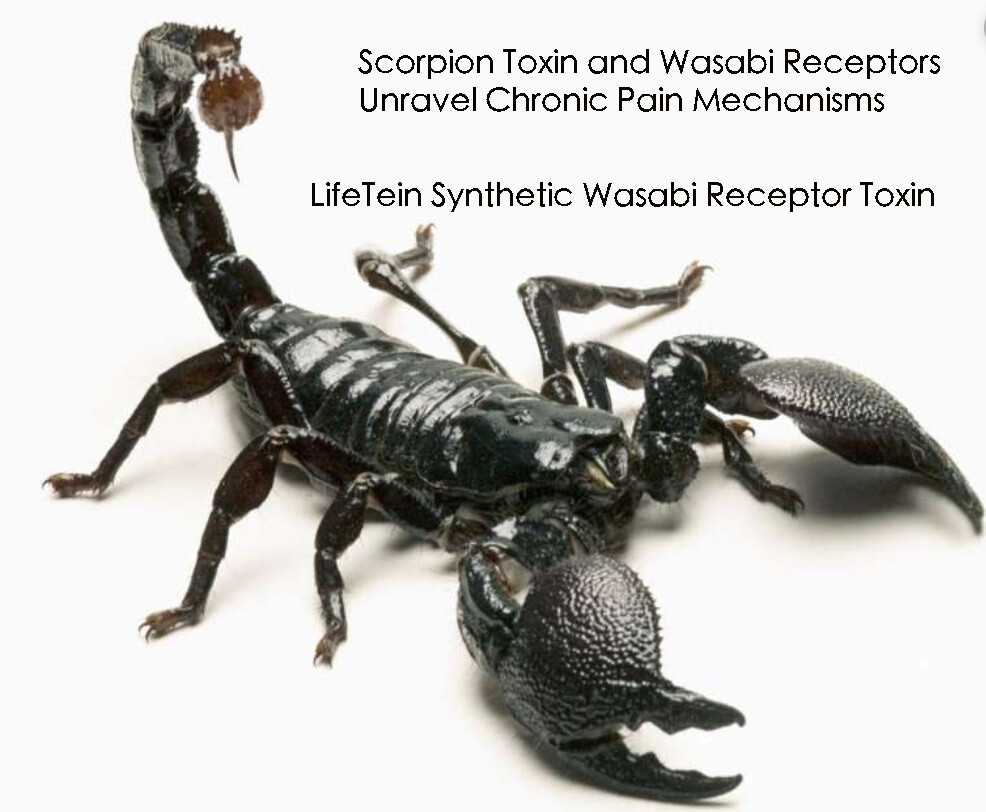
Researchers at the University of California, San Francisco (UCSF), in collaboration with LifeTein, have made a groundbreaking discovery in the field of pain management. LifeTein’s expertise in peptide synthesis was crucial in developing synthetic scorpion toxin peptides that specifically target the “wasabi receptor,” a key player in the body’s response to certain types of pain.
The wasabi receptor, scientifically known as TRPA1, is an ion channel protein that triggers the familiar sinus-clearing or eye-watering sensation experienced when consuming wasabi or cutting onions. This receptor is also implicated in the perception of chronic pain.
The focus of this research is a peptide derived from scorpion toxin, referred to as WaTx. Remarkably, WaTx, synthesized by LifeTein, can activate the TRPA1 receptor, mimicking the pain response to irritants. Unlike other molecules, WaTx has the unique ability to penetrate cell membranes directly, bypassing the need for channel proteins. This property makes it an invaluable tool for studying chronic pain and inflammation.
In addition to its research applications, WaTx holds promise for the development of new, non-opioid pain therapies. It has been observed to induce pain and pain hypersensitivity without causing neurogenic inflammation, a common side effect of many pain treatments.
Expanding the Horizon: Spider Venom and Chronic Pain
Further expanding on this concept, a study titled “Identification and Characterization of ProTx-III [μ-TRTX-Tp1a], a New Voltage-Gated Sodium Channel Inhibitor from Venom of the Tarantula Thrixopelma pruriens” delves into the potential of spider venoms in pain management. This study, conducted by F. C. Cardoso and colleagues, discovered a novel inhibitor, μ-TRTX-Tp1a (Tp1a), from the venom of the Peruvian green-velvet tarantula. Tp1a selectively inhibits human NaV1.
7 channels, which are key contributors to pain perception.
The study found that Tp1a, both in its recombinant and synthetic forms, preferentially targets NaV1.7 channels, offering a new avenue for analgesic drug development. Unlike many other spider toxins affecting NaV channels, Tp1a does not significantly alter the voltage dependence of activation or inactivation of these channels. This unique feature of Tp1a was demonstrated to be effective in reversing spontaneous pain in animal models.
The structural analysis of Tp1a revealed an inhibitor cystine knot motif, common in spider toxins but with distinct pharmacological properties that could be crucial in developing more selective and potent treatments for chronic pain.
Conclusion
The research at UCSF, along with the findings on spider venom peptides and the significant contributions of LifeTein in peptide synthesis, represents a significant step forward in understanding and potentially treating chronic pain. These discoveries highlight the vast potential of natural toxins in medical research, offering hope for more effective and safer pain management strategies in the future.
Reference:
- Lin King, J. V., Emrick, J. J., Kelly, M. J. S., Herzig, V., King, G. F., Medzihradszky, K. F., & Julius, D. (2019). A Cell-Penetrating Scorpion Toxin Enables Mode-Specific Modulation of TRPA1 and Pain. Cell. doi:10.1016/j.cell.2019.07.014
